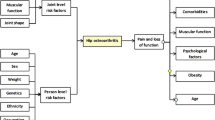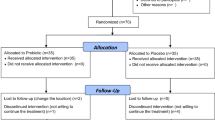Abstract
We compared type I collagen degradation using serum cross-linking C-terminal telopeptide (ICTP) in 18 patients with rapidly destructive osteoarthrosis and in 20 patients with slowly progressive osteoarthrosis of the hip. The diagnosis was established by clinical examination and radiographic evaluation. Total hip arthroplasty was performed in all patients. Serum levels of ICTP, bone-specific alkaline phosphatase, osteocalcin and N-terminal propeptide were studied. Patients with rapidly destructive osteoarthrosis had higher mean (SD) serum ICTP levels than patients with slowly progressive osteoarthrosis [13.2 (5.6) versus 3.7 ng/ml (1.4), p=0.001] whereas no significant difference of all other markers was seen between the groups. Elevation of ICTP levels correlated significantly with decreased joint-space width assessed by radiographs of the hip (p=0.01). Our data suggest that rapidly destructive hip osteoarthrosis is associated with elevated serum ICTP levels, reflecting increased collagen type I degradation.
Résumé
Nous avons comparé la dégradation du collagène type I en utilisant le cross-linking du telopeptide Terminal C (ICTP) chez 18 malades avearthrose rapidement destructrice et chez 20 malades avecarthrose lentement progressive de la hanche. Le diagnostic a été établi par examen clinique et évaluation radiographique. L’arthroplastie totale de la hanche a été exécuté chez tous les malades. Le niveau sérique d’ICTP, des phosphatases alcalines osseuse spécifiques, de l’ostéocalcine, et du propeptide N-Terminal a été étudié. Les malades avec arthrose rapidement destructrice avaient une moyenne du niveau d’ICTP nettement plus haute que les malades avec arthrose lentement progressive [13.2 (5.6) vs 3.7 ng/ml (1.4), p=0.001], alors qu’aucune différence notable de tous les autres marqueurs n’a été notée entre les groupes. L’élévation de niveau de l› ICTP était en corrélation avec la hauteur de l’interligne articulaire apprécié par des radiographies (p=0.01). Nos données suggèrent que l’arthrose rapidement destructive est associé à une élévation sérique de l’ICTP reflétant une augmentation de la dégradation du collagène de type I.


Similar content being viewed by others
References
Berger CE, Kröner A, Thomas E, Kristen KH, Ogris E, Engel A (2002) Comparison of biochemical markers of bone metabolism in serum and distal femur aspirates. Clin Orthop 395:174–179
Boutry N, Paul C, Leroy X, Fredoux D, Migaud H, Cotton A (2002) Rapidly destructive osteoarthritis of the hip: MR imaging findings. Am J Roentgenol 79:657–663
Chevalier X, Conrozier T, Gehrmann M, Claudepierre P, Mathieu P, Unger S, Vignon E (2001) Tissue inhibitor of metalloproteinase-1 (TIMP-1) serum levels may predict progression of hip osteoarthritis. Osteoarthr Cartil 9:300–307
Conrozier T, Chappuis-Cellier C, Richard M, Mathieu P, Richard S, Vignon E (1998) Increased serum C-reactive protein levels by immunonephelometry in patients with rapidly destructive hip osteoarthritis. Rev Rhum (Engl Ed) 65:759–765
Delmas PD (1999) Biochemical markers of bone turnover in Paget’s disease of bone. J Bone Miner Res 14 (Suppl 2):66–69
Eriksen E, Charles P, Melsen F, Mosekilde L, Risteli L, Risteli J (1993) Serum markers of Type I collagen formation and degradation in metabolic bone disease: Correlation with bone histomorphometry. J Bone Miner Res 8:127–132
Flik K, Vargas JH III (2001) Rapidly destructive hip disease: a case report and review of the literature. Am J Orthop 30:549–552
Garnero P, Conrozier T, Christgau S, Mathieu P, Delmas PD, Vignon E (2003) Urinary type II collagen C-telopeptide levels are increased in patients with rapidly destructive hip osteoarthritis. Ann Rheum Dis 62:939–943
Garnero P, Ferreras M, Karsdal MA, Nicamhlaoibh R, Risteli J, Bort O, Qvist P, Delmas PD, Foged NT, Delaisse JM (2003) The type I collagen fragments ICTP and CTX reveal distinct enzymatic pathways of bone collagen degradation. J Bone Miner Res 18:859–867
Hakala M, Aman S, Luukkainen R, Risteli L, Kauppi M, Nieminen P, Risteli J (1995) Application of markers of collagen metabolism in serum and synovial fluid for assessment of disease process in patients with rheumatoid arthritis. Ann Rheum Dis 54:886–890
Harris WH (1969) Traumatic arthritis of the hip after dislocation and acetabular fractures: treatment by mold arthroplasty. An end-result study using a new model of evaluation. J Bone Joint Surg Am 51:737–55
Komiya S, Inoue A, Sasguri Y, Minamitani K, Morimatsu M (1992) Rapidly destructive arthropathy of the hip. Studies on bone resorptive factors in joint fluid with a theory of pathogenesis. Clin Orthop 284:273–282
Kotaniemi A, Risteli J, Aho K, Hakala M (2003) Increased type I collagen degradation correlates with disease activity in reactive arthritis. Clin Exp Rheumatol 21:95–98
Laroche M, Moineuse C, Durroux R, Mazieres B, Puget J (2002) Can ischemic hip disease cause rapidly destructive hip osteoarthritis? Jt Bone Spine 69:76–80
Lequesne M (1993) Rapidly progressive destructive diseases of the hip. Ann Radiolelectr (Paris). 36:62–64
Matsumoto F, Uzuki M, Kaneko C, Rikimaru A, Kokubun S, Sawai S (1997) Expression of matrix metalloproteinases (MMPs) and tissue inhibitor of metalloproteinases (TIMPs) in joint tissues of rapidly destructive coxarthropathy (RDC), analysed by a immunohistochemical study. Ryumachi 37:688–695
Meneghello A, Franceschi E (1996) Destructive arthrosis of the hip. Natural history, pathogenesis and radiographic features. Radiol Med (Torino). 92:186–192
Piaggesi A, Rizzo L, Golia F, Costi D, Baccetti F, Ciacco S, De Gregori S, Vignali E, Trippi D, Zampa V, Marcocci C, Del Prato S (2002) Biochemical and ultrasound tests for early diagnosis of active neuro-osteoarthropathy (NOA) of the diabetic foot. Diabetes Res Clin Pract 58:1–9
Postel M, Kerboull M (1970) Total prosthetic replacement in rapidly destructive arthrosis of the hip. Clin Orthop 72:138–144
Qvist P, Christgau S, Pedersen BJ, Schlemmer A, Christiansen C (2002) Circadian variation in the serum concentration of C-terminal telopeptide of type I collagen (serum CTx): effects of gender, age, menopausal status, posture, daylight, serum cortisol, and fasting. Bone 31:57–61
Rosenberg ZS, Shankman S, Steiner GC, Kastenbaum DK, Norman S, Lazansky MG (1992) Rapid destructive osteoarthritis: clinical, radiographic, and pathologic features. Radiology 182:213–216
Ryu KN, Kim EJ, Yoo MC, Park YK, Sartoris DJ, Resnick D (1997) Ischemic necrosis of the entire femoral head and rapidly destructive hip disease: potential causative relationship. Skelet Radiol 41:311–313
Schneider U, Schmidt-Rohlfing B, Knopf U, Breusch SJ (2002) Effects upon bone metabolism following total hip and total knee arthroplasty. Pathobiology 70:26–33
Wilkinson JM, Hamer AJ, Rogers A, Stockley I, Eastell R (2003) Bone mineral density and biochemical markers of bone turnover in aseptic loosening after total hip arthroplasty. J Orthop Res 21:691–696
Author information
Authors and Affiliations
Corresponding author
Rights and permissions
About this article
Cite this article
Berger, C.E., Kröner, A., Stiegler, H. et al. Elevated levels of serum type I collagen C-telopeptide in patients with rapidly destructive osteoarthritis of the hip. International Orthopaedics (SICOT) 29, 1–5 (2005). https://doi.org/10.1007/s00264-004-0608-4
Received:
Accepted:
Published:
Issue Date:
DOI: https://doi.org/10.1007/s00264-004-0608-4




